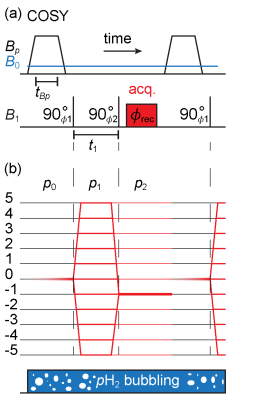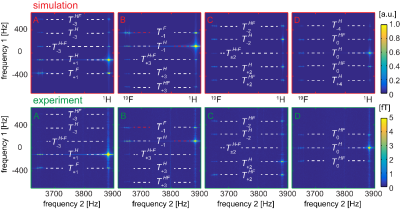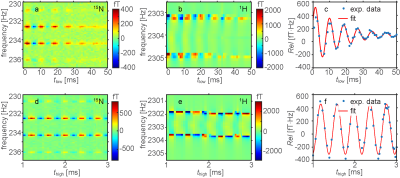1883
Hyperpolarized multiple quantum coherences at ultra-low magnetic fields increase 15N parahydrogen-induced polarization1SBMI, MOIN CC, UKSH, Kiel University, Kiel, Germany, 2High-Field Magnetic Resonance Center, Max Planck Institute for Biological Cybernetics, Tübingen, Germany, 3Institute for Biometrics and Medical Informatics, Otto-von-Guericke University, Magdeburg, Germany
Synopsis
We used signal amplification by reversible exchange of parahydrogen (SABRE) at low (~1 mT) and ultra-low (~1 μT, ULF) magnetic fields. We proposed and used ULF correlation spectroscopy (COSY) method to analyze PHIP spin order in real-time. Coherences up to the third-order were observed experimentally. Furthermore, we analyzed SABRE in alternating magnetic fields (alt-SABRE). We measured the evolution of 1H-15N zero-quantum coherences and have shown that they persist during field alternation and depend on the magnetic field strength. The resulting 15N-polarization in the alt-SABRE experiment was with magnetic was appoximately 30% higher.
Introduction
Parahydrogen-induced polarization (PHIP) is a fast developing, cost-efficient hyperpolarization method. Here, we study the parahydrogen (pH2) spin order distribution at low magnetic fields using a PHIP variant called signal amplification by reversible exchange (SABRE).[1] Our goal was to understand in more detail the spin distribution at low (~1mT) and ultra-low fields (~1μT, ULF). PHIP and SABRE already featured high 13C and 15N polarization levels above 20%. Ultimately we want to increase these levels making the method even more attractive for in vivo applications. We used a superconducting quantum interference device (SQUID) based ULF NMR system to observe hyperpolarization build-up and evolution for any nuclear spins in real-time.Methods
pH2 generator. We used a liquid helium dipstick filled with iron-oxide to enrich the parahydrogen fraction of H2 close to 100%. The flow rate was set to 2–3L/h.[2] SABRE (Figure 1).[1] When the Ir-catalyst is activated in the presence of H2 and the substrate (here acetonitrile, MeCN, or 3-fluoropyridine, 3FP, Figure 1) and pH2 is used instead of normal H2, then the enriched singlet spin order of pH2 can be distributed in the active SABRE complex [Ir]. As a result, bounded substrates also get polarized. The constant exchange of labile ligands allows refreshment of spin order depleted H2 in [Ir] with fresh pH2 and exchange of polarized bounded substrate with a nonpolarized free substrate. Hence, the lifetime of [Ir] complex must be long enough for spin order distribution (polarization transfer). However, the lifetime should not be too long compared to T1 relaxation; otherwise, only a tiny amount of free substrates is polarized.[3] Therefore, the main challenge of SABRE is to enable efficient spin order transfer from pH2 to a substrate. By efficient, we usually mean a high amplitude and fast compared to the lifetime of [Ir]. SQUID NMR.[4] We used a SQUID-based NMR spectrometer that operates at B0≈54µT. The system is ideal for low and ultralow NMR spectroscopy and allows measurement of any heteronuclear simultaneously. During the entire experiment, pH2 is continuously supplied with a flow rate of ≈2.5L/h for convenience. Susceptibility effects on magnetic field homogeneity are negligible during pH2 bubbling, which is demonstrated by the spectral linewidth <0.5 Hz at B0≈54 µT. ULF COSY (Figure 2).[2] This is an adaptation of high-resolution correlation spectroscopy for low fields. It enables observation of hyperpolarized high-order quantum coherences. SABRE-SHEATH and alt-SABRE-SHEATH (Figure 3).[5] Usually, pH2 to 15N spin order transfer occurs at the magnetic field of 1uT (SABRE-SHEATH conditions). Here we used an alternating magnetic field (alt-SABRE-SHEATH).Results
Multiple quantum coherences (MQF, Figure 4). We observed that high order spin states are generated in the low-field SABRE experiment with a polarization field Bp=5.2mT (Figure 4). Using the ULF COSY experiment, we were able first to measure high order coherences and differentiate them using a 4 step post-processing phase cycle technique. The four-step phase cycling allowed us to distinguish 2n, 2n+1, 2n+2, and 2n+3 coherences, with n an integer number. Homonuclear (TH or TF) and heteronuclear (THF) coherences from -3 to +3 were visible experimentally. 1H-15N spin order transfer (Figure 5). We alternated between two different magnetic fields: Blow~1μT and Bhigh~55μT with corresponding time intervals tlow and thigh. Polarization transfers from pH2 to 15N of a substrate was measured with the frequency vlow=119±1Hz and vhigh=2541±13Hz. Oscillations deemed at Blow on the time scale of 50ms. The resulting alt-SABRE-SHEATH 15N polarization was 30% higher than in the SABRE-SHEATH experiment with a constant magnetic field. Both experiments were reproduced using spin dynamics simulations.[2,5,6]Discussion
Observation of multiple quantum coherences confirmed the hypothesis that high-order multi-spin states are populated at ULF. As a result, polarization is indeed distributed among many spins. The deuteration of untargeted protons was proposed.[7] This solves the problem of distributing the spin-order among numerous spins because protons and deuterons are weakly coupled at a field above 1μT. However, this strategy would not be as efficient for SABRE-SHEATH experiments, where almost all spins are strongly coupled. Traditionally SABRE-SHEATH is carried out in a constant magnetic field where all coherences are averaged out, and as a result, lower polarization for a specific nucleus is gained. Alternating magnetic fields make use of the fast oscillating coherences. Spin order starts at a lower field and then accelerates at a higher field. It is essential that the lifetime of the [Ir] complex is long compared to the polarization transfer rate. We are planning to add a temperature control unit and analyze the effect of temperature on alt-SABRE-SHEATH efficiency.Conclusion
We were able to detect high order coherences and spins states up to third order. This is a clear demonstration of spin order distribution among coupled spins. We introduced the alt-SABRE-SHEATH approach and increased the 15N polarization of acetonitrile by 30% compared to conventional SABRE-SHEATH. This approach will be extended to other 15N labeled metabolites like nicotinamide and drugs like metronidazole. Their clinical imaging application is to be investigated; however, the lifetime of more than 1 minute at clinical 1-3T MRI and 15N-polarization above 20% looks very promising.[8]Acknowledgements
We acknowledge funding from the German Federal Ministry of Education and Research (BMBF) within the framework of the e:Med research and funding concept (01ZX1915C), DFG (PR-1868/3-1, BU-2694/6-1, PL-576/6-1, HO-4602/2-2, HO-4602/3, GRK2154-2019, EXC2167, FOR5042, TRR287), Kiel University and the Faculty of Medicine. MOIN CC was founded by a grant from the European Regional Development Fund (ERDF) and the Zukunftsprogramm Wirtschaft of Schleswig-Holstein (Project no. 122-09-053).References
[1] M. J. Cowley, R. W. Adams, K. D. Atkinson, M. C. R. Cockett, S. B. Duckett, G. G. R. Green, J. A. B. Lohman, R. Kerssebaum, D. Kilgour, R. E. Mewis, J. Am. Chem. Soc. 2011, 133, 6134–6137.
[2] K. Buckenmaier, K. Scheffler, M. Plaumann, P. Fehling, J. Bernarding, M. Rudolph, C. Back, D. Koelle, R. Kleiner, J.-B. Hövener, A. N. Pravdivtsev, ChemPhysChem 2019, 20, 2823–2829.
[3] D. A. Barskiy, A. N. Pravdivtsev, K. L. Ivanov, K. V. Kovtunov, I. V. Koptyug, Phys. Chem. Chem. Phys. 2016, 18, 89–93.
[4] K. Buckenmaier, M. Rudolph, P. Fehling, T. Steffen, C. Back, R. Bernard, R. Pohmann, J. Bernarding, R. Kleiner, D. Koelle, M. Plaumann, K. Scheffler, Rev. Sci. Instrum. 2018, 89, 125103.
[5] A. N. Pravdivtsev, N. Kempf, M. Plaumann, J. Bernarding, K. Scheffler, J.-B. Hövener, K. Buckenmaier, ChemPhysChem n.d., n/a, DOI 10.1002/cphc.202100543.
[6] A. N. Pravdivtsev, J.-B. Hövener, Chem. Eur. J. 2019, 25, 7659–7668.
[7] P. J. Rayner, M. J. Burns, A. M. Olaru, P. Norcott, M. Fekete, G. G. R. Green, L. A. R. Highton, R. E. Mewis, S. B. Duckett, PNAS 2017, 201620457.
[8] J. F. P. Colell, A. W. J. Logan, Z. Zhou, R. V. Shchepin, D. A. Barskiy, G. X. Ortiz, Q. Wang, S. J. Malcolmson, E. Y. Chekmenev, W. S. Warren, T. Theis, J. Phys. Chem. C 2017, 121, 6626–6634.
Figures




